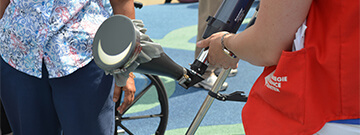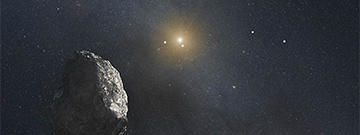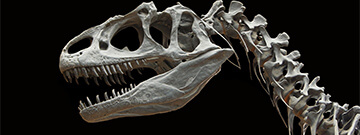
Space Junk!
When you think of space, you probably think of a vast empty area with nothing in sight. While that is true, humans have actually left their mark in space. We have launched tens of thousands of rockets and many more satellites into orbit since the 1950s, and thousands of destroyed satellites, as well as fragments from all the rockets we’ve ever fired, are in orbit around our planets. Scientists are soon finding that the “marks” we’ve left on space are in fact harmful, and we call them space junk.
Space junk, also known as space debris, refers to any piece of equipment or debris left in space by humans. It can be used to describe large objects like satellites that have failed and were left in orbit after their missions. It may also be used to describe tiny objects like paint flecks or debris that have fallen off a rocket. The United States Space Surveillance Network was monitoring more than 15,000 objects in orbit that were more than 10 centimeters (four inches) in diameter as of 2021.
But what can these tiny pieces even do to cause harm? Every year, all satellites, including the International Space Station (ISS) where humans reside, conduct hundreds of collision avoidance maneuvers. Since objects circle Earth at great speeds, up to 8 km (5 miles) per second, even a little collision with space junk can inflict damage to a spacecraft. For instance, damage from encounters with debris smaller than one millimeter, or four hundredths of an inch, frequently required the replacement of space shuttle windows. According to scientists, there are millions of objects of that size in space. Luckily, space junk doesn’t currently represent a serious threat to our exploration endeavors. Its greatest threat is to other satellites that are in orbit. To avoid being struck and maybe being damaged or destroyed by all this approaching space debris, these satellites must maneuver out of the path.
So, how do we get rid of all this junk? Every year, all satellites, including the International Space Station (ISS), where humans dwell, do hundreds of collision prevention measures. All businesses are requested by the United Nations, a worldwide organization that works to improve living conditions around the world (and beyond!), to withdraw their satellites from orbit within 25 years after the completion of their mission. Yet, because satellites may stop working —and frequently do—it is difficult to enforce this. Several businesses from across the world have developed creative methods to address this issue. Dead satellites may be drawn back into the atmosphere and removed from orbit, where they would otherwise burn up. We might do this by harpooning a satellite, trapping it in a massive net, grabbing it with magnets, or even shooting lasers at the satellite, causing it to fall out of orbit.
We can lessen the issue of space trash in the future by ensuring that satellites are removed from orbit once they are no longer usable. Thanks to the Earth’s orbit, we can study our planet, communicate, and much more. It’s crucial that we use it wisely so that future generations can profit from it as well.
Source:
Garcia, Mark. “Space Debris and Human Spacecraft.” ![]() NASA, NASA, 14 Apr. 2015.
NASA, NASA, 14 Apr. 2015.
“What Is Space Junk and Why Is It a Problem?” ![]() Natural History Museum.
Natural History Museum.
Scientific Peer Review by Alysia Mandato
Aneri Shethji:
Aneri Shethji is a 10th grader at North Allegheny Intermediate High School. She is very passionate about science and writing and enjoys getting involved with the community. In her free time, Aneri spends time with friends and family and loves getting outside. She can’t wait to learn more about all that science has to offer, and help others learn it too!

On April 8, 2024, we will witness a mesmerizing event. A total solar eclipse is upon us, and here at the Science Center, we can explore this celestial phenomenon in many ways.
But first, what is this event? A ...

Climate change is a big deal. We’ve all seen news stories about greenhouse gas emissions, rising temperatures, and the hole in our ozone layer. However, what tends to sometimes be overlooked is climate change’s ...

In the captivating world of health care, a fascinating transformation is taking place—a rise in Artificial Intelligence, or AI! Picture a world where smart machines team up with doctors to revolutionize medicine, making ...

Hydroponics, a contemporary farming method, redefines how we grow plants, offering a fresh approach to cultivating crops that differs from traditional soil-based farming. This innovative technique doesn’t rely on soil ...

In our solar system, the eight planets—Mercury, Venus, Earth, Mars, Jupiter, Saturn, Uranus, and Neptune—are talked about more than anything. While the ...

Quantum computers are on the forefront of technological advancement. These machines, unlike any traditional computers you’re familiar with, harness the ...

The Earth is a spectacle of constant movement. Periodically, it commands our attention with displays of power—earthquakes. These events are tied to the intricate movements of the Earth's tectonic plates. Tectonic ...

Have you ever wondered how investigators in crime shows manage to identify suspects with such accuracy? Dusting for fingerprints isn’t always feasible in many cases, so the true answer lies in a different type of ...

Writers: Evan Allen, Ricardo Aguilar, Jillian Pensenstadler, Amelia Foley, and Ian Lisien
Once a center of industrial prowess, Pittsburgh has undergone a remarkable transformation, ...

Have you ever questioned what happens to the food you consume? Prepare yourself for a thrilling voyage as we go through your digestive system! We'll look at ...

When someone falls on their arm, they immediately head to the hospital to see if it is hurt. X-rays are used by doctors to examine your bones more ...

Even though dinosaurs became extinct about 65 million years ago, we know quite a bit about them, including what they ate, where they lived, and even what ...



